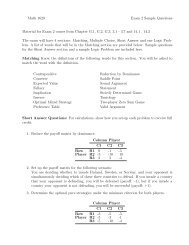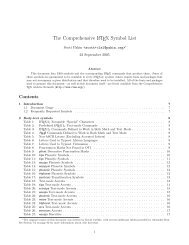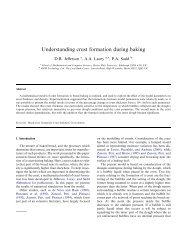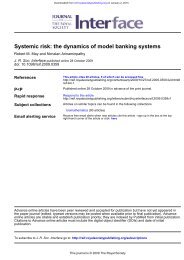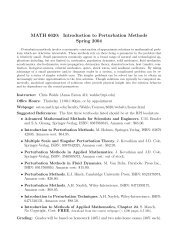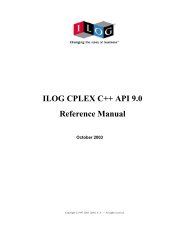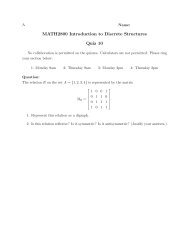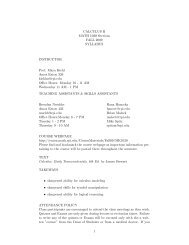On converging shock waves of spherical and polyhedral form
On converging shock waves of spherical and polyhedral form
On converging shock waves of spherical and polyhedral form
You also want an ePaper? Increase the reach of your titles
YUMPU automatically turns print PDFs into web optimized ePapers that Google loves.
376 D. W. Schwendeman<br />
characteristic <strong>form</strong>. The third equation is already in characteristic <strong>form</strong>, while a linear<br />
combination <strong>of</strong> the first <strong>and</strong> second equations in (3.7) gives<br />
mF u (u) du<br />
dx + G v(u) dv = 0, (3.10)<br />
dx<br />
which holds on characteristics with slope dy/dx = m, where m is a root <strong>of</strong> the<br />
quadratic<br />
m 2 F u (u) − m(F v (u) + G u (u)) + G v (u) = 0. (3.11)<br />
We now eliminate m from equations (3.10) <strong>and</strong> (3.11), <strong>and</strong> use the definitions <strong>of</strong> F<br />
<strong>and</strong> G in (3.8) to obtain the differential <strong>form</strong><br />
(u 2 + v 2 + w 2 )(du 2 + dv 2 ) = (1 + β 2 )(udu + vdv) 2 , β 2 = − MA′<br />
A , (3.12)<br />
which holds on the two families <strong>of</strong> characteristics. Again, it is convenient to use polar<br />
coordinates, u = r cos ϑ, v = r sin ϑ, so that the differential <strong>form</strong> in (3.12) becomes<br />
dϑ<br />
dr = ± [ β 2 r 2 − w 2<br />
r 2 (r 2 + w 2 )<br />
] 1/2<br />
. (3.13)<br />
For the strong <strong>shock</strong> case, β 2 = n <strong>and</strong> (3.13) may be integrated (keeping in mind that<br />
w is constant) to give<br />
ϑ 2 − ϑ 1 = ±[P (r 2 , w) − P (r 1 , w)], (3.14)<br />
for a <strong>shock</strong>-expansion transition from a state (r 1 , ϑ 1 , w) to (r 2 , ϑ 2 , w). The function<br />
P (r, w) in (3.14) plays the role <strong>of</strong> a Pr<strong>and</strong>tl–Meyer function, <strong>and</strong> is given by<br />
P (r, w) =<br />
√ ( n<br />
2 ln r 2 + n − 1<br />
2n w2 + √ pq )<br />
− 1 ( p 2<br />
n 2 arctan − q 2<br />
2pq<br />
where p 2 = nr 2 − w 2 <strong>and</strong> q 2 = r 2 + w 2 . The choice <strong>of</strong> sign in (3.14) reflects the two<br />
families <strong>of</strong> <strong>shock</strong>-expansion solutions <strong>and</strong> can be made following the condition that<br />
ϑ increases with increasing y for both families.<br />
We now have the necessary <strong>form</strong>ulas available to complete the solution <strong>of</strong> the<br />
Riemann problem. The solution consists <strong>of</strong> constant states in u separated by <strong>shock</strong><strong>shock</strong>s<br />
or <strong>shock</strong>-expansions given by (3.9) <strong>and</strong> (3.14), respectively, with w = w l or w r ,<br />
<strong>and</strong> a contact discontinuity at y = 0 across which w jumps from w l to w r <strong>and</strong> G <strong>and</strong><br />
u are continuous. A numerical method <strong>of</strong> iteration is used to determine the solution<br />
<strong>and</strong> in particular the values <strong>of</strong> G <strong>and</strong> u. The iteration begins with values for each<br />
constant state given by a linearization <strong>of</strong> the equations. Newton’s method is used to<br />
update the values for u iteratively until the values for G <strong>and</strong> u on y = 0 converge<br />
to within a specified tolerance (taken to be 10 −6 ). These values become ˜G k <strong>and</strong> ũ k in<br />
(3.2) <strong>and</strong> (3.3), respectively.<br />
The numerical method described in §§ 3.1 <strong>and</strong> 3.2, essentially a Godunov method,<br />
is first-order accurate if the left <strong>and</strong> right states for the Riemann problem at each<br />
face are taken from the discrete data at neighbouring grid cells alone. Higher-order<br />
methods (for smooth regions <strong>of</strong> the solution) could be obtained by making corrections<br />
to the left <strong>and</strong> right states based on discrete approximations for the gradient <strong>of</strong> u<br />
(see Schwendeman 1999, for example). This is not done here because <strong>of</strong> the added<br />
numerical cost, mainly, <strong>and</strong> because for many <strong>of</strong> the problems computed the solutions<br />
contain regions <strong>of</strong> uni<strong>form</strong> (or nearly uni<strong>form</strong>) u separated by <strong>shock</strong>-<strong>shock</strong>s. We also<br />
note that approximate Riemann solvers could be used but since the problems <strong>of</strong><br />
interest involve collisions <strong>of</strong> <strong>shock</strong>-<strong>shock</strong>s an exact Riemann solver is preferred.<br />
)<br />
,


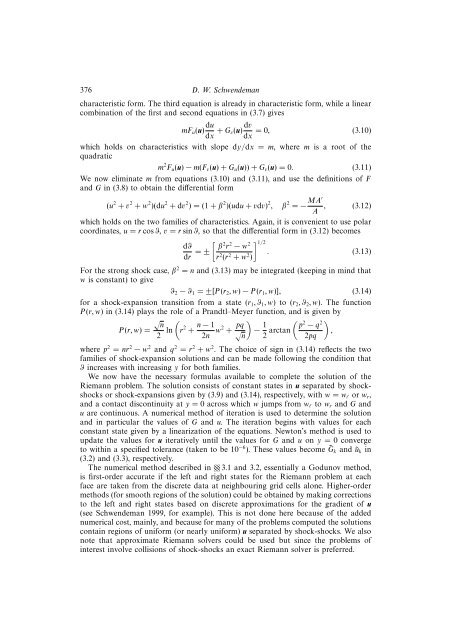
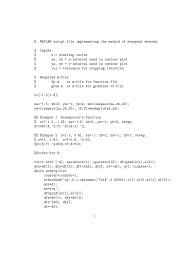

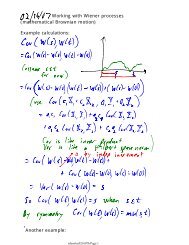

![MATH 1500 Sample Questions Exam 2 1. [3.7] A 10-ft plank is ...](https://img.yumpu.com/43861920/1/190x245/math-1500-sample-questions-exam-2-1-37-a-10-ft-plank-is-.jpg?quality=85)
